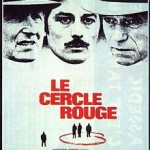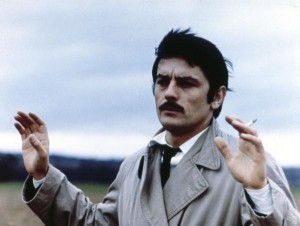“Le Cercle Rouge” plays Saturday, Nov. 6, at 4 p.m. at the Egyptian Theatre in Hollywood as part of AFI FEST 2011.
Le Cercle Rouge/1970/EIA, et al/140 min./in French with English subtitles
By Michael Wilmington
 Jean-Pierre Melville (1917-1973) was, in some ways, the Vermeer of the heist movie. A master of classic noir and neo noir, Melville was a cool, sure-fingered expert and an immaculate artist. Like Vermeer, his pictures were deceptively simple and utterly haunting, punctilious and mysterious. And, like Vermeer, he didn’t leave many behind him.
Jean-Pierre Melville (1917-1973) was, in some ways, the Vermeer of the heist movie. A master of classic noir and neo noir, Melville was a cool, sure-fingered expert and an immaculate artist. Like Vermeer, his pictures were deceptively simple and utterly haunting, punctilious and mysterious. And, like Vermeer, he didn’t leave many behind him.
One of the greatest of all Melville’s films, with one of his most spectacular heists, is “Le Cercle Rouge,” a neo-noir which has, as its centerpiece, a spine-chilling depiction of a jewel robbery at the Place Vendome in Paris.
The job is pulled off with rare skill by three strangely honorable thieves, played by three international film stars: ex-convict Corey (played by Alain Delon), escaped prisoner Vogel (Gian Maria Volonté) and ex-cop Jansen (Yves Montand).
The movie is about how these three come together, how they execute the robbery, and how they’re finally driven apart – largely through the quiet skill and determination of their relentless police antagonist. Deceptively lumpish, bourgeois-looking Inspector Mattei is played by comedy star André Bourvil.
Mattei is keeping watch over his prisoner, Vogel, on a train journey. But Vogel slips out of his handcuffs and escapes from the sleeper car of the speeding train. Mattei is humiliated, then obsessed with finding Vogel. The broken handcuffs become a psychological link.
Mattei has an invaluable source in Santi (François Périer), a double-dealer and underworld mole, who looks like a ferret in a suit. Santi owns a nightclub that seems to specialize in crooked assignations and ersatz ’50s American movie musical numbers, set to a cool jazzy score by Éric Demarsan. (The chorus girls in those numbers are almost the only women we see in the movie, except for one faithless lover and one cigarette girl.)
The title “Le Cercle Rouge” refers to a story of Buddha, who supposedly draws a red chalk circle and explains to his students that those who are destined to cross paths will do so within the circle, no matter what.
Melville made and released Le Cercle Rouge in 1970, one year after making his World War Two French Resistance masterpiece, “Army of Shadows” (1969) and two years before making his last film (with his last heist), the flawed “Un Flic” (Dirty Money), starring Delon, Catherine Deneuve and Richard Crenna. “Le Cercle Rouge” was his last masterpiece.
Back to Vermeer for a moment. There is one vital quality of Vermeer’s that Melville misses completely, probably never tries for: warmth. Melville’s films noirs are cold, especially when cinematographer Henri Decaë (of Melville’s “Le Samourai”) shoots them. His crooks are cool. They speak little, wear raincoats and fedoras, and smoke cigarettes, like Bogie. His cops are icy. His world is dark: noir to the brim.
Why was Melville so obsessed with criminals, with heists and with heist movies? Maybe because this underworld reminded him of the world that was the French Resistance, in which he had fought during the war.
And maybe it’s because of the one that got away. In the ’50s, Melville was hired to direct the movie that became one of the greatest of all heist movies (François Truffaut’s choice as the greatest of all film noirs), 1955’s “Rififi.” Melville was later fired and replaced by Jules Dassin, who chivalrously refused to take the job without Melville’s consent (which Melville gave). [Read more…]











From FNB readers